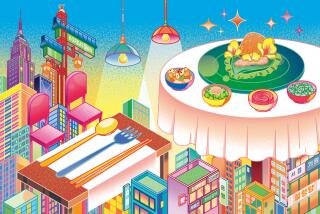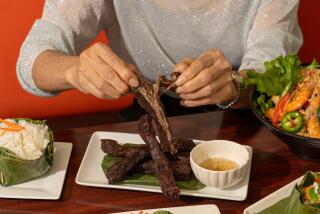How steak and ‘ramdon’ illustrate class tensions in Bong Joon Ho’s ‘Parasite’
- Share via
There’s a moment in Bong Joon Ho’s “Parasite” when an affluent housewife (Cho Yeo Jeong) interrupts a rainy drive home with her husband and two children to phone her just-hired low-income housekeeper (Jang Hye Jin), instructing her to head into their high-tech kitchen and get a warming pot of “ram-don” going.
“What the hell is ‘ram-don’?” the housekeeper asks aloud, and just like that, the making of a mystery dish is turned into a nail-biter of a scene.
Since the film’s breakout release — it has already grossed $91 million — YouTube has been filling up with how-to “ram-don” videos. In them, instant black bean ramen noodles made by the South Korean brand Chapagetti and Neoguri’s spicy seafood-flavored Korean udon are combined in a broth made of boiling water and the contents of their accompanying seasoning packets, which are then topped with cubes of seared sirloin.
If you’re thinking of scouring the internet for a food site offering instructions for making “ram-don,” save yourself some time. Those fluent in Korean would tell you that the housewife in the movie is actually directing her maid to prepare a popular Korean quick food, jjapaguri, a word so hard to translate that for the English subtitles “Parasite” translator Darcy Paquet chose instead to invent a name not known in any language but that would merge the words “ramen” and “udon.”
Bong said he came up with the steak-on-a-pile-of-instant noodles as a way of showing how the wealthy housewife wanted to please her young son but how she also regarded jjapaguri as food for commoners.
“This is something kids like, regardless of the rich or the poor,” Bong explained via email. “But the rich wife couldn’t stand her kid to eat this cheap noodle so she adds sirloin topping.”
More to Read
Eat your way across L.A.
Get our weekly Tasting Notes newsletter for reviews, news and more.
You may occasionally receive promotional content from the Los Angeles Times.







